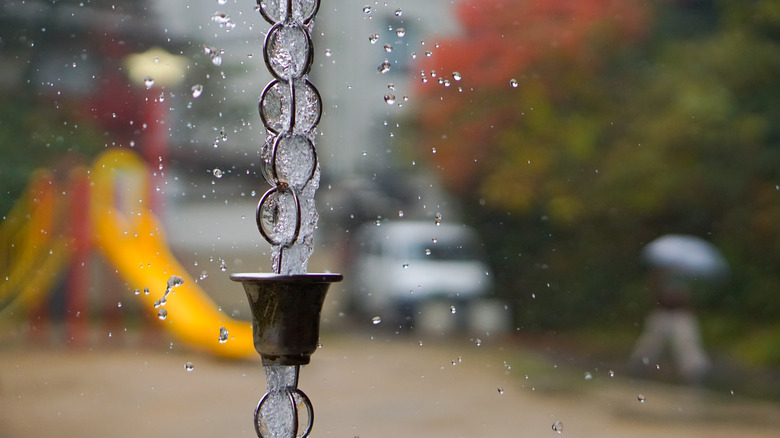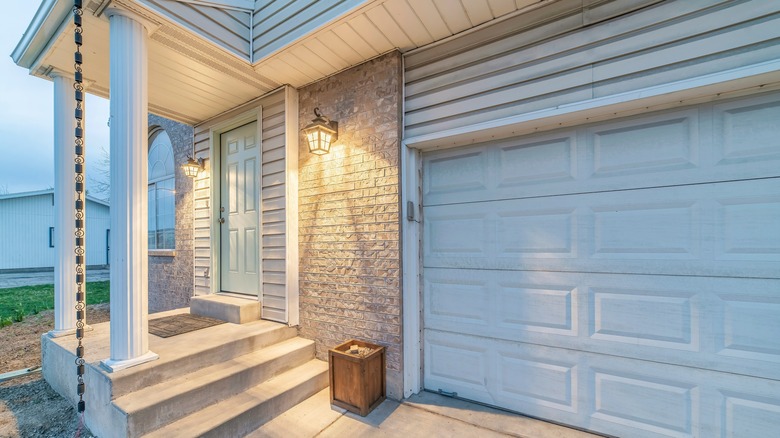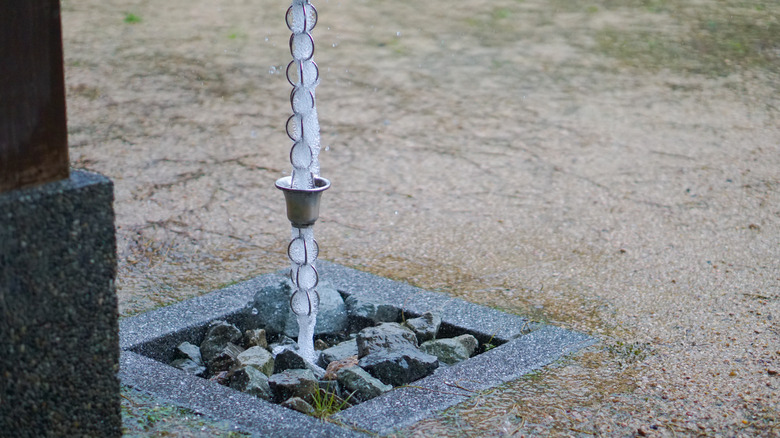What To Know About Rain Chains And How They Can Help Your Garden
Keeping a garden happy can feel like a never-ending cycle. Most gardeners know that too much moisture in the soil can cause disease, nutrient deficiency, and other serious issues for plant roots. However, an article by Utah State University also explains how over-draining your garden can create coarse, rocky soil that causes water stress in plants. When plants are stressed from too much or too little water, they fail to thrive. To prevent a variety of problems, homeowners need a way to reliably collect rainwater and gently distribute it into their garden bed without overwhelming their drainage systems. The elegant solution? A rain chain.
Rain chains are long, decorative metal chains that can serve a very important purpose for your garden. Connected to the gutter or eave of your house, rain chains guide drops of water slowly down into your garden's soil. According to World Water Reserve, rain chains are also a beautiful option for funneling water into a separate storage vessel, such as a rain barrel. Rain stored from the rain chain won't flood your garden, and it can later be used for irrigation when needed.
Benefits of a rain chain for your garden
Overwatering is bad for plants, but it can also be damaging to the greater environment. Raindrops washing over the hard surfaces in your garden can contribute to flooding and soil erosion, even if you have other stormwater drainage solutions in place. One way to prevent flooding is to establish a rain garden filled with native plants and grasses (via Garden Culture Magazine). A rain chain is another tool specifically designed to prevent runoff and water waste while benefitting those rain gardens. Rain chains can divert the drops into your rain garden, where they'll soak into the soil with your native plants.
In addition to providing benefits to your garden and the environment, rain chains add an aesthetic appeal to your home's exterior. Downspouts aren't as visually pleasing, so many water-conscious homeowners opt for rain chains instead (via World Water Reserve). It's easy to find rain chains in a variety of metallic shades and styles; avid DIY-ers may even enjoy crafting their own! Rain chains are the perfect ornament for those who love relaxing or meditating in their zen garden. When each drop hints at a link or bucket on the chain, it creates a lovely tinkling sound, and it's fun to watch the drops gently make their way down into the soil.
How to use a rain chain
Rain chains, also known as Kusari-toi, first appeared on Japanese tea houses as early as the mid-16th century, according to retailer Seo Rain Chain. Since then, they've come to adorn residential and public buildings all around the world. One of the features that makes rain chains so popular is that they're incredibly easy to install and use. A simple V-shaped hook latches onto the opening of your gutter, anywhere a drainpipe would normally fit. V-hooks are great for areas with light rainfall, but Rain Chain in a Nutshell recommends that homeowners use an installation kit with a short spout for heavy-duty rain chains. Installation kits with spouts will help to guide water onto the chain and prevent it from splashing against your house.
That's it! After installation, your rain chain will do all the work, creating a relaxing water feature every time it rains and distributing water gently towards the ground. It's best to hang your rain chain over an area where you want water to flow, such as a flower bed or a garden under the eave of your house. You can also hang your rain chain over a water feature, such as a koi pond, rain barrel, fountain, or dry creek. Seo Rain Chain suggests planting vines and climbing plants around your rain chain to create a lively green ambiance, but the options are limitless when it comes to building your perfect rain garden!


